Chicago embraces and delves deeply into the fringes of comic art, music and ‘anti-high-art’ culture. This city is rife with non-conformist talent. Onsmith, a cartoonist who basks in the Midwest capital’s dialogue produces provocative, insightful, and frequently uncomfortable meditations that reflect the city’s fascination with the edges of artistic practice. The COMP Magazine recently visited his Edgewater studio to discuss the impact of mini-comics, zines and DIY culture, his aesthetic influences, and why the mundane is cannon fodder for a derelict response.
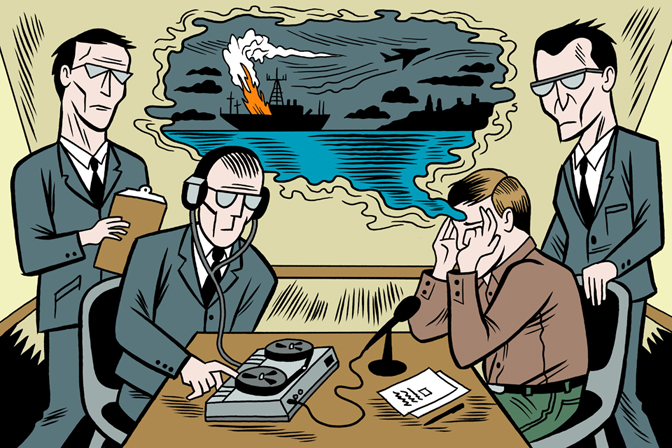
Onsmith, Psychic Spies, Narratively Magazine, 2014
How did you get involved in comics? You’re from out west, Oklahoma I believe? Were comics readily available when you were younger? Can you provide a little background on how you ended up here in Chicago?
Well, like many cartoonists, I grew up reading superhero comics, newspaper comics, childrens’ books, pretty much anything that was hand drawn and narrative. My brother was a big artistic influence on me when we were young. We made up characters and comic strips and later redrew heavy metal album covers. Around the end of high school, I got really into self-publishing, specifically zines and mini-comics at that time categorized as “alternative” like so many other things. I grew up in a small town in Oklahoma and the mini-comics and zines could really only be found in Oklahoma City. I ordered them through the mail too from catalogs like Last Gasp, Factsheet 5, and the Zine Guide. A few years after the end of high school, I had reached my limit with rural Oklahoma and decided to move back to the region where I’m originally from: southern Wisconsin. My dad worked for General Motors and that’s what brought us to Oklahoma when I was 3. So in 1998, I moved to Madison, Wisconsin. I met some great people there but I really had my eye on Chicago. I was already romanticizing it by reading Nelson Algren’s work. Many of my favorite cartoonists were from Chicago too: Chris Ware, Ivan Brunetti, Dan Clowes, and a whole slew of folks making mini-comics. So in 2000, I moved to Chicago and quickly became involved in the comics community.
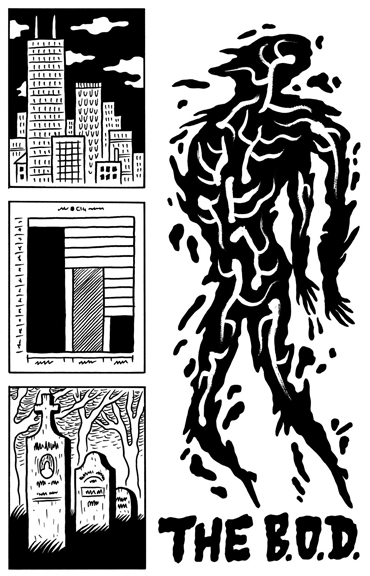
Onsmith, The Bod Cover, 2012
You are noted for your work in mini-comics. Can you share your attraction to this format versus that of the traditional long form graphic novel or the mainstream monthlies?
Mini-comics were a source freedom for me when I was younger, not only in terms of DIY publishing but also of thought and culture. I love the graphic novel format as well as the serialized “floppy” but for me, I tend to publish in small doses. I’ve done a lot of work for anthologies and I still turn to mini-comics to get something out there quickly. I aspire to create a longer narrative but I still see the worth in self-publishing mini-comics. They’re stripped down, easy to produce, and relatively inexpensive to print. There’s probably something about the control and ease that appeals to me as well. In the comics class I teach, I have my students create mini-comics by the end of the semester. As I tell them, it’s how so many of today’s leading cartoonists started: making mini-comics and selling them at conventions and comics shops.
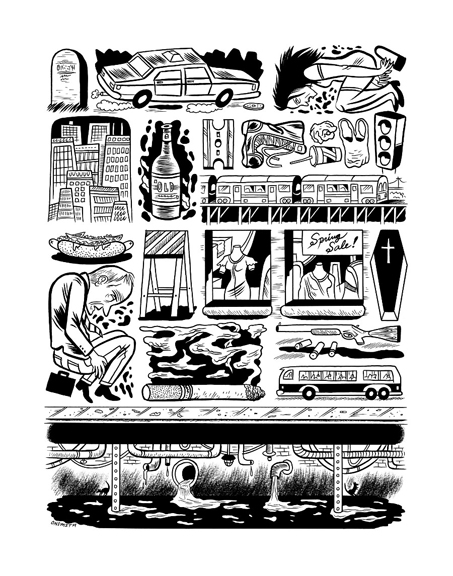
Onsmith, Chasing Posada Publication, 2014
I see you are a fan of doodling. Is this a part of your process. Can you describe your aesthetic practice? What piques your interest and eventually evolves into a finished work?
Sure, I try to doodle almost every day. I like to write down titles, fragments, overheard bits of conversation and combine them with doodles of different characters. I don’t have a solid process I use every time since every story I make demands a different approach. I change it up often but yes, many of my doodles and fragments of writing end up making the content of my comics. One story in particular, “Re-engineering Strategy” that was published in Black Eye vol. 2, was mostly made up of notes and doodles I jotted down in my sketchbook. I crafted the narrative around these fragments to make it more cohesive. That story in particular started with me writing down that a boss in an office didn’t have a name, but instead was simply known as “The Sadist”. In the past, I’ve developed comics based on only a title, something I witnessed, dreams I’ve had; really, anything that compels me to make a comic. Comics are quite laborious after all.
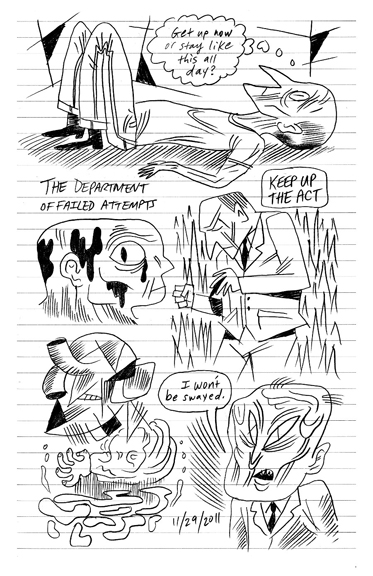
Onsmith, Sketchbook Page, 11-29-11
Can you provide a little insight into the comic’s culture (or scene) here in Chicago. Are there any specific creators that you are fond of?
As mentioned before, Chris Ware, Ivan Brunetti and Dan Clowes have all been very influential. There’s so many cartoonists in Chicago now, it’s really hard to keep track. I’d say there’s definitely a community here, albeit made up of a lot of folks toiling away at comics alone. There are collaboratives, however, that are much more about the social aspect and the collaborative exchange that can happen in comics. I’m speaking mainly of the “Trubble Club”; an evolving collective of cartoonists creating jam comics and appearing publicly at events where they invite the public to collaborate as well. Plus, now that we have our own alternative/art-comics/small press convention here (CAKE, Chicago Alternative Comics Expo), there’s really a lot more going on and more outlets for people’s comics to be seen.
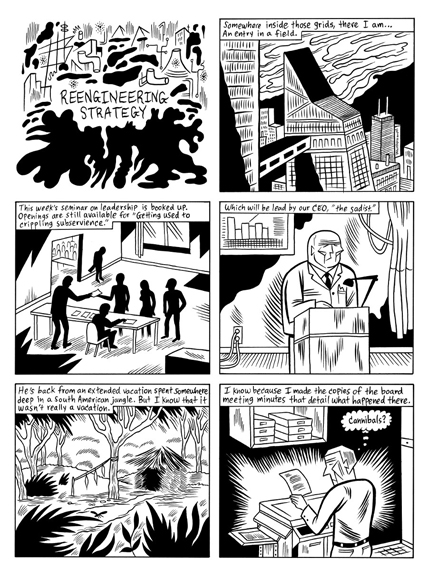
Onsmith, Reengineering Strategy, page-1, 2012
Modern comic history is relatively young. Some historians note Rodolphe Töpffer (1799-1846) as being the earliest recognized practitioner in European comics. Are there any seminal past cartoonist whom you find to be relevant in your practice or whom you reference on occasion?
Oh, there’s probably too many to mention here! I have a fondness for comics around the 30s through the late 40s, specifically gags and shorter strips. Some of my favorite cartoonists include Ernie Bushmiller, Virgil Partch (VIP), Winsor McCay, Milt Gross, William Steig, Saul Steinburg, and several others. For me, I’ve concentrated on so many comics anthologies, they’re really a gauge of when someone may have got their mind blown by comics. There’s the generation that were into Zap when it was coming out. There’s the Raw generation. For me, it was Zero Zero, published by Fantagraphics Books, which ran from 1995 to 2000. Much like music, this made me hunt down other anthologies and works by these cartoonists. Buzzard and Snake Eyes are also two very influential anthologies to me.
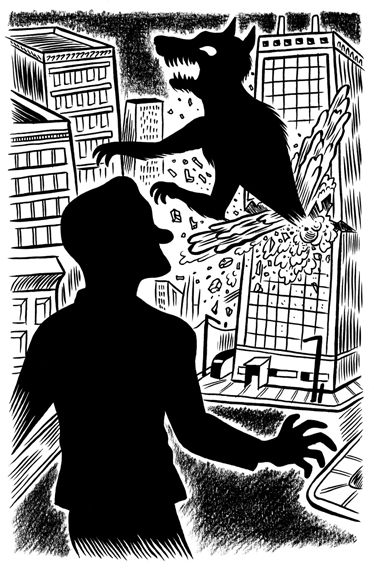
Onsmith, Loss Adjustment Drawing Series, 2014
What’s shaking in 2015? Do you have specific comics you are hoping to complete? Any small book or comic fairs you plan to participate in?
I’m hoping to finally complete the collection of comics I am to publish with Yam Books, entitled “Diminished Returns”. I’m also to make some new work for a couple of anthologies. CAKE (the Chicago convention I mentioned) is happening in the coming months so I’ll most likely put together a new mini-comic to sell there. I don’t make a lot of material really but once I get going, it comes quick.
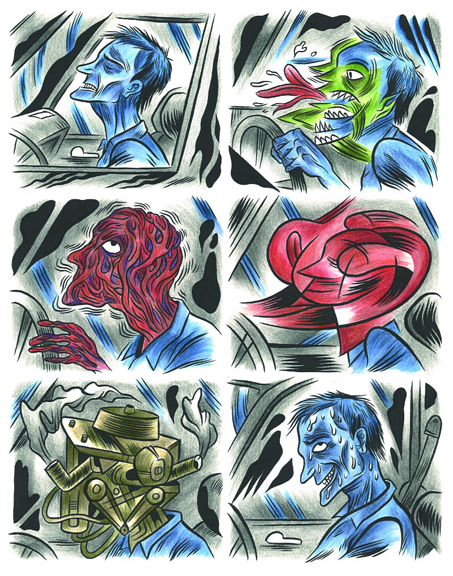
Onsmith, JG Ballard Crash Adaptation, 2011
Onsmiths comics are widely available in print and on the web. Onsmith lives happily in the Edgewater neighborhood of Chicago with the painter Sara Renae Holloway making sporadic pronouncements directed at questioning conventions of proper social behavior.
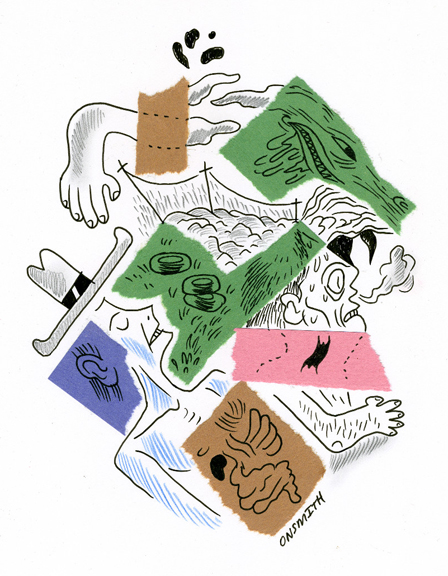
Onsmith, Collage Doodle, unpublished, 2013
For additional information on the work of Onsmith, please visit:
Onsmith – http://onsmith.tumblr.com/
Spudnik Press – http://www.spudnikpress.org/shop/residency-artwork/paul-nudd-and-onsmith-head-heaps/
Yam Books – http://www.yambooks.com/diminished-returns-onsmith/
Rotland Press – http://rotlandpress.com/
Trubble Club – http://blog.trubble.club/
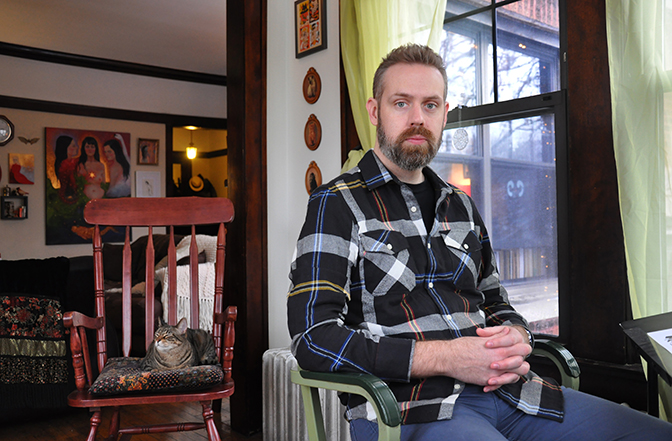
Onsmith, cartoonist, Chicago, IL, 2015
Interview and portrait by Chester Alamo-Costello


